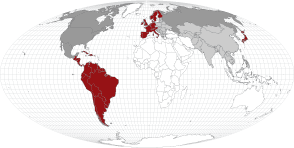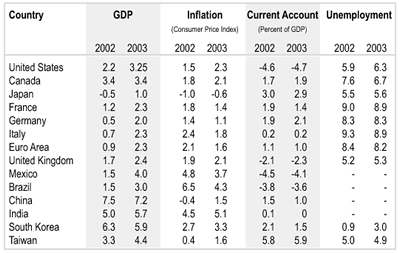The International Economy
Kelley School of Business, Indiana University, Bloomington
World economic growth for 2002 is estimated at 2.2 percent, measured in terms of real Gross Domestic Product (GDP), compared to growth rates of 4.7 percent in 2000 and 2.2 percent in 2001. The International Monetary Fund in Washington forecasts world economic growth for 2003 at a disappointing 2.8 percent and points to evidence for a probably even lower growth rate.
The world still lacks a power engine, a growth locomotive to help pull other regions out of economic struggles. The recovery in the U.S. and Europe is delayed and more modest than originally hoped. Japan is still stuck with a combination of deflation and a very low growth rate of GDP with the imminent risk of falling back into recession. Moreover, Latin America is on the brink of an economic collapse. Gleams of hope are the prospects for Southeast Asia and, to a smaller extent, for Middle and Eastern Europe and Russia (see Table 1).
Table 1
Growth Comparisons for Selected Countries
Europe
Despite already modest forecasts for the growth rate of real GDP, the core European countries performed even worse than predicted. Germany's growth rate of real GDP in 2001 was a diminutive 0.5 percent. France, Italy, and the United Kingdom all showed growth rates of GDP below 2.0 percent. The picture for 2003 looks only slightly brighter with an expected economic growth rate of 2.3 percent for the European Union.
The explanation for this gloomy outlook is multifaceted. With low domestic demand, Europe's economic prospects depend largely on dynamic export growth. The dramatic stock market price decline further weakened domestic consumption and investment. Universal banks and life insurers keep huge unrealized losses from large equity holdings in their balance sheets that depress lending. In contrast to the U.S., and not well understood by economists, productivity growth in Europe is declining and tarnishes growth perspectives. Considering the rapid aging of European society, far-reaching reforms of the social insurance schemes and the labor markets are urgently needed. While current interest rate levels are appropriate for Euro-member countries with inflation rates above 3.0 percent (such as Ireland and Spain), they are clearly too high for Germany, Italy, and France. Furthermore, the strict rules of the stabilization pact do not allow the needed fiscal stimulus.
North America
The best guess for the U.S. economy is a continued but modest economic recovery and a growth of real GDP slightly above 3.0 percent. Productivity growth rates are encouraging signals for a continuing self-sustained growth path.
NAFTA members are closely integrated through trade. Canada and Mexico are strongly dependent on U.S. demand for their exports. Real GDP growth for Mexico and Canada in 2003 is expected to be considerably above the world average with around 4.0 percent and 3.4 percent, respectively.
Latin America
The outlook for most countries in Latin America is murky. The Argentine full-blown debt default sent shock waves to Uruguay, Paraguay, and Bolivia. Whether the former will be able to avoid a financial collapse in 2003, despite a generous International Monetary Fund loan in 2002, is an open question. While Venezuela suffers considerable political and economic uncertainty, Brazil—by far the biggest economy of the continent—is at risk of defaulting on its debt.
Russia and Eastern Europe
Russia and most Middle and Eastern European countries are doing well and look rather optimistically toward 2003 with expected growth rates of about 4.0 percent. Still, these economies are too small to have a profound effect on world economic growth.
Asia
The picture for emerging economies in 2003 looks very diverse. Asia recovered surprisingly fast and well from the recession; real GDP growth for 2003 is estimated at 6.1 percent. Highlights are China and India with forecasted growth rates of 7.2 percent and 5.7 percent, respectively.
Japan
Japan seems unable to come out of its economic calamity. Real GDP growth is estimated to be at -0.5 percent in 2002 while a meek increase of 1.0 percent is predicted for 2003. However, even this modest forecast might be overly optimistic. Export growth is jeopardized by a stronger yen against the U.S. dollar and the euro. With a government debt of roughly 150 percent of GDP, not much scope for a financial stimuli package is left. Essentially, Japan has not redressed the real causes of the economic disaster; that is cleaning up the balances of banks and enterprises, thereby tackling the non-performing debt problem and allowing insolvent economic entities to go bust. The dramatic decline of stock prices aggravated the situation because banks held large portfolios of equities. Political power struggles block any attempt for a fundamental change.

The Risks
A possible war against Iraq presents a large risk in this forecast. Another risk is the projected U.S. Current Account deficit of almost $500 billion, which is around 4.7 percent of GDP. A reversal of capital flows could cause a rapid and dramatic devaluation of the U.S. dollar against other key currencies, such as the euro and the yen. This would badly distort world trade and harm world economic growth. However, the dynamic productivity growth rate in the U.S. is a hint that it might be continuously attractive to invest here.
The risk of a Brazilian default is acute. With an overall debt of almost $300 billion—a little more than 60 percent of GDP—it is hard to understand how stern the situation really is. It is the debt structure more than the actual level of debt that causes concern. After the last monetary reform in 1994, the Brazilian government tried to minimize the financing cost of government debt by indexing sovereign bonds either against the U.S. dollar or the short-term domestic interest rate. Consequently, any devaluation of the domestic currency (the real) or an increase of the domestic interest rate to avoid a further slipping of the currency increases the debt burden. Brazil seems to be caught in a vicious cycle. Only if the new government is able to reverse the devaluation trend of the real and to lower real interest rates will Brazil have a realistic chance to avoid a fall-back into monetary chaos and economic contraction. The contagious shock waves from such an event would be devastating for the whole continent.
Also in this Issue…
- Outlook for 2003
- The U.S. Economy
- The International Economy
- Financial Forecast
- Housing
- Indiana
- Anderson
- Bloomington
- Columbus
- Evansville
- Fort Wayne
- Gary
- Indianapolis
- Kokomo
- Lafayette
- Muncie
- New Albany
- Richmond
- South Bend/Mishawaka and Elkhart/Goshen
- Outlook Summary for 2003
- Return to Table of Contents




